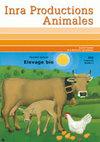Les besoins en eau d'abreuvement des bovins laitiers : déterminismes physiologiques et quantification
IF 0.6
4区 农林科学
Q3 Agricultural and Biological Sciences
引用次数: 6
Abstract
Drinking water is an incompressible need of dairy farms. It represents a significant cost and, an immediate consequence of its restriction is a decrease in milk yield and an alteration of animal welfare. Animal water balance is maintained thanks to regulation of renal excretion of water and thirst in responses to set points related to plasmatic osmotic pressure and blood volume. Numerous predictive equations for water requirements of dairy cows have been published. Diet dry matter content is the first determinant of drinking water volume because it determines the relative part of feed water and drinking water in the total amount of water intake. Dry matter intake, diet contents of sodium, potassium and nitrogen and ambient temperature are the main determinants of total water intake. The comparison of the prediction error of the predictive equations on a common data set showed contrasted performances. The choice of an equation should be based on the nature of the available predictors and the conditions in which it was established. Given that most of the predictive equations for dairy cow water requirements are established from individual measurements, their application to a herd watered through constant trough level requires adjustments. Some elements are also given in the paper to predict the water requirements of heifers.奶牛饮水需求:生理决定论与定量
饮用水是奶牛场不可压缩的需求。它代表着巨大的成本,限制它的直接后果是产奶量的减少和动物福利的改变。动物的水平衡是通过调节肾脏对水的排泄和口渴的反应来维持的,这些反应与血浆渗透压和血容量有关。许多预测奶牛需水量的公式已经发表。日粮干物质含量是决定饮水量的第一决定因素,因为它决定了采食量中饲料水和饮水的相对比例。干物质采食量、饲粮钠、钾、氮含量和环境温度是决定总摄水量的主要因素。在一个共同的数据集上对预测方程的预测误差进行了比较,得到了不同的结果。选择一个方程应根据现有预测因素的性质和建立它的条件。鉴于大多数奶牛需水量的预测方程都是根据个人测量建立的,因此将它们应用于通过恒定槽位浇灌的牛群需要进行调整。文中还给出了预测小母牛需水量的一些要素。
本文章由计算机程序翻译,如有差异,请以英文原文为准。
求助全文
约1分钟内获得全文
求助全文
来源期刊

Inra Productions Animales
Multiple-
CiteScore
1.30
自引率
33.30%
发文量
0
审稿时长
>36 weeks
期刊介绍:
This journal publishes scientific update reports, results of experiments and their possible applications, analyses on topical issues and presentation of research, information on scientific events and new publications.
INRA Productions Animales deals with all species of zootechnical interest (herbivores, monogastrics and fish), covering feed and nutrition, physiology, pathology, genetics, production techniques, product quality and production economics.
 求助内容:
求助内容: 应助结果提醒方式:
应助结果提醒方式:


